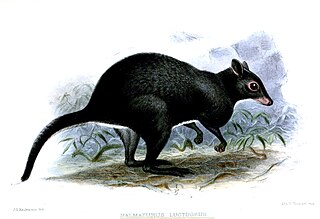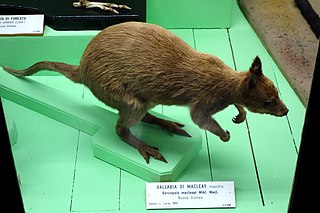
A wallaby is a small or middle-sized macropod native to Australia and New Guinea, with introduced populations in New Zealand, Hawaii, the United Kingdom and other countries. They belong to the same taxonomic family as kangaroos and sometimes the same genus, but kangaroos are specifically categorised into the four largest species of the family. The term "wallaby" is an informal designation generally used for any macropod that is smaller than a kangaroo or a wallaroo that has not been designated otherwise.

The spectacled hare-wallaby is a species of macropod found in Australia and New Guinea. In Australia, a small sub-population is found on Barrow Island, while the mainland type is widespread, though in decline, across northern regions of the country.

Doria's tree-kangaroo is a long-tailed, furry, bear-like mammal found only in tropical mountain forests on the island of New Guinea. It is one of the largest tree-kangaroos, living alone in trees and active at night to feed on leaves or fruit. It belongs to the macropod family (Macropodidae) with kangaroos, and carries its young in a pouch like other marsupials. Threats include hunting and habitat loss.

The tenkile, also known as Scott's tree-kangaroo, is a species of tree-kangaroo in the family Macropodidae. It is endemic to a very small area of the Torricelli Mountains of Papua New Guinea. Its natural habitat is subtropical or tropical dry forests. It is threatened by habitat loss and by hunting. The tenkile is listed as endangered due to hunting and logging activities in Papua New Guinea. The tenkile is hunted for its meat, and is the main protein source for the residents of Papua New Guinea. The population of Papua New Guinea has increased in recent years due to improvements in healthcare; therefore increasing need in tenkile meat which means that more tenkiles are being hunted. Additionally, tenkiles are poached for their fur and are captured and sold as a part of the illegal pet trade. Domesticated dogs also hunt tenkiles. Deforestation in Papua New Guinea affects all tree-kangaroos, however industrial logging that occurs in the Torricelli Mountain Range decreases the species' already restricted habitat. The Torricelli Mountain Range faces additional deforestation due to the timber industry, and the production of coffee, rice and wheat.

The ursine tree-kangaroo is a long-tailed, furry, bear-like mammal found only in tropical forests on the island of New Guinea. Slightly larger than a cat, it lives alone in trees and is active at night to feed on leaves and fruit. It belongs to the macropod family (Macropodidae) with kangaroos, and carries its young in a pouch like other marsupials. It has a small range in northwestern New Guinea and is threatened by habitat loss and hunting. Other common names for this species include the black tree-kangaroo, the Vogelkop tree-kangaroo and the white-throated tree-kangaroo.

The black dorcopsis or black forest wallaby is a species of marsupial in the family Macropodidae. It is endemic to an island at the eastern end of New Guinea where its natural habitat is subtropical or tropical dry forests. It is threatened by habitat loss and hunting, its population is declining and the IUCN lists it as being "Critically endangered".

The white-striped dorcopsis or greater forest wallaby is a species of marsupial in the family Macropodidae. It is found in the northern part of West Papua, Indonesia and Papua New Guinea. It is a common species in suitable tropical forest habitat and the IUCN lists its conservation status as being of "Least concern".

The gray dorcopsis or gray forest wallaby is a species of marsupial in the family Macropodidae. It is found in West Papua and Papua New Guinea.

The brown dorcopsis, also known as the brown forest wallaby, is a species of marsupial in the family Macropodidae. It is endemic to the lowlands of West New Guinea and the nearby Indonesian islands in West Papua of Misool, Salawati, and Yapen.

Dorcopsulus is a genus of small marsupials in the family Macropodidae, known as forest wallabies. They are native to dry forests of New Guinea.

The small dorcopsis or lesser forest wallaby is a species of marsupial in the family Macropodidae. It is found in the mountainous interior of West Papua and Papua New Guinea. Its natural habitat is subtropical or tropical dry forests. It is less common than it used to be and the IUCN has assessed it as being "near threatened".

The northern glider is a species of marsupial in the family Petauridae. It is endemic to Papua New Guinea, becoming known to science in 1981 after being discovered in the Torricelli Mountains. This species has been found in primary, mid-montane tropical moist forests. It is also known from rural gardens close to forest. The northern glider is Critically Endangered because its occurrence is less than 100 km2, all individuals are located within a single area, and a continuing decline of its habitat quality due to deforestation and human encroachment. They also face a major threat from hunting.

The black-spotted cuscus is a species of marsupial in the family Phalangeridae. It is among the largest members of the family, only being surpassed by the bear cuscus. It is a relatively colourful species found in forests of northern New Guinea. It is threatened by hunting and habitat loss, and has already disappeared from large parts of its range. Consequently, it is rated as Critically Endangered by IUCN.

The dusky pademelon or dusky wallaby is a species of marsupial in the family Macropodidae. It is found in the Aru and Kai islands and the Trans-Fly savanna and grasslands ecoregion of New Guinea. Its natural habitats are subtropical or tropical dry forests, dry savanna, subtropical or tropical dry shrubland, and subtropical or tropical dry lowland grassland. It is threatened by habitat loss.

Calaby's pademelon, also known as the alpine wallaby, is a species of marsupial in the family Macropodidae. It is endemic to Papua New Guinea. It is threatened by habitat loss and hunting.

The dorcopsises are the marsupials of the genera Dorcopsis and Dorcopsulus. They are found in the tropical forests of New Guinea and Southeast Indonesia. They are placed in the subfamily Macropodinae, along with other Australasian marsupials such as wallabies, kangaroos, tree-kangaroos, pademelons, and quokkas.

The Central Range montane rain forests is a tropical moist forest ecoregion on the island of New Guinea. The ecoregion covers the Central Range of the New Guinea Highlands, which extends along the spine of the island. The montane rain forests of the ecoregion are distinct from the surrounding lowland forests, and are home to many endemic plants and animals.
The long-nosed paramelomys is a species of rodent of the family Muridae endemic to New Guinea. It is found in the lowlands of the south of the country.

The Vogelkop–Aru lowland rain forests is a tropical moist forest ecoregion in Indonesia. The ecoregion covers the peninsular lowlands of western New Guinea, along with the Aru Islands and other nearby islands.



















